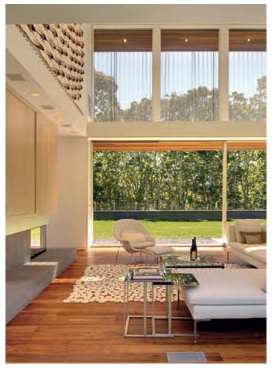Heating, ventilation and air-conditioning (HVAC) systems regulate room temperature, humidity and airflow to maintain a comfortable indoor environment (HVAC Home 2006). They can range from a simple electric baseboard heater to a complex system with ducts and lobed grilles for high mixing ventilation. Due to their importance in removing air pollutants, odours and stale air, it is necessary to negotiate balance between their cost and efficiency.
Before choosing a system it is vital to consider the size of the dwelling, its spatial configuration, its exterior envelope and the budget. Such factors can dictate the size and type of a chosen system and influence the required air velocity, temperature and energy efficiency.
For heating considerations, there are multiple air and water methods that one can choose from, such as baseboard heaters, fossil fuel central heating systems, active thermal solar heating and geothermal heating. They can be combined with others such as heat recovery ventilators (HRV) and designed for passive solar gain (Strongman 2008). For ventilation, one can choose from central duct, passive circulation and a simple ductless convection system (Stein and Reynolds 2000). These can be enhanced through the usage of the thermal chimney effect, the ridge-and-soffit vent system, grille selection, under-floor displacement ventilation and filter selection (Nastase and Meslem 2010, Sustainable Sources 2011c, Barrista 2004). Lastly, for air conditioning, it is advisable to use passive cooling options – such as natural and artificial shading, thermochemical glass, the thermal chimney effect and geothermal cooling, among others – prior to resorting to costly energy consuming technologies. Once passive air-conditioning systems are introduced, there are numerous methods to choose from for active air conditioning. They range from individual space coolers, such as window units, to central AC systems and are selected on the basis of efficiency and cost.
When choosing an HVAC system, the air-tightness of the building envelope must first be reviewed. When the envelope is highly airtight, a smaller system will be sufficient and affordable. Furthermore, factors such as indoor spatial arrangement can affect the required size. For example, if a house has many rooms, then a larger ducting network will be required to adequately supply and vent air, as opposed to a house with an open floor plan.

Figure 14.1: A geothermal heat pump uses the ground’s ambient temperature as a source to heat or cool the home.
It is important to note that bigger is not always better when it comes to equipment size. HVAC systems that are too large for their respective dwellings will ‘short cycle’, causing them to fall short of their designated efficiency (AZEM 2011). Properly sized equipment, however, operates for longer at maximum efficiency and therefore creates a comfortable atmosphere by providing consistent temperature and humidity levels. Furthermore, because the average system loses 3 to 4 per cent efficiency every year, HVAC systems only last 10 to 20 years on average (AZEM 2011). Therefore, it is necessary to have long-lasting, appropriately sized equipment.
When a central heating system is chosen, it is recommended that a heat recovery ventilator (HRV) be installed (Strongman 2008). While small wall-mounted HRVs are available, they are typically placed in the loft and attached to ducts from centralized systems. Such a system involves the usage of a heat-transfer module, which transfers the heat from old air to cold incoming air, allowing fresh air to be drawn in with little wasted energy. This can also be reversed in the summer to conserve indoor cold air (Strongman 2008). Since this system uses energy to run the fans of the heat transfer module and central ducts, the use of natural ventilation along with passive solar heating and cooling techniques is recommended.

Figure 14.2: A heat recovery ventilator (HRV) uses a module to transfer the heat from old warm air to cool incoming air to save energy.
The chimney effect is a passive method used to naturally air-condition while supplying a dwelling with fresh outdoor air. It functions by allowing hot air to rise throughout the stairwells and vertical spaces of a house to the chimney, where it is released into the atmosphere. It then creates a vacuum, which draws in cool air through open windows placed at ground level (Sustainable Sources 2011b). This method only works with an existing or initially planned circulation route in which the air can enter near the ground and ascend through the chimney without being blocked.
A ridge-and-soffit system is a method used to passively vent air within an attic to prevent moisture and pollutant build-up. This system can be described as a ‘continuous, weather-shielded opening at the peak of the roof in combination with continuous screened openings along the eaves of the house’ (Sustainable Sources 2011c). This system is similar to the thermal chimney method, but is designed to function within an attic space.
The grille type for supply and exhaust vents is another part of ventilation design. For example, a stamp face grille allows only 50 per cent airflow, whereas a bar type grille allows 80 per cent (AZEM 2011). Even more efficient, however, is the recently developed lobed grille. A recent study by Ilinca Nastase and Amina Meslam suggests that using ‘innovative, rectangular air-diffusion grilles with lobed ailerons ensures higher mixing in a room than baseline jets from classical, rectangular air-diffusion grilles with straight ailerons’, and therefore ensures uniform flows to reduce thermal discomfort and draught sensations (Nastase and Meslem 2010).
Choice of filter is also important in HVAC systems. Homeowners typically choose the thick filters, which are known to block allergy-causing dust (AZEM 2011). These filters, however, restrict airflow and add strain to an HVAC system, which in returns requires it to run more often, using up more energy and decreasing its lifespan. Therefore, it is recommended to use thinner filters, such as 30-day fibreglass ones, and change them frequently (AZEM 2011).
Under-floor displacement ventilation (UDV) is a more innovative and efficient way to ventilate structures than the traditional overhead forced air system (Barrista 2004). Typically used in larger structures, this system lightly supplies air from 20 cm (8 in) floor vents; the air then exits the space through ceiling vents. This reduces the load on the system, which only has to condition the air where the people are, rather than trying to condition the entire space. Consequently, these systems use slightly warmer air when conditioning: 17.2°C (63°F) rather than 13.9°C (57°F). With lower air velocity, smaller fans and smaller ductwork, the overall energy and installation costs are reduced by a substantial amount (Barrista 2004).
Designers should also be aware that duct leakage is a major contributor to poor indoor air quality. Leaks in ductwork can contribute 20 to 60 per cent of air leakage in a house (Sustainable Sources 2011a). It is also known that as much as 33 per cent of a dwelling’s costly air-conditioned air can leak into attics or other spaces that do not require ventilation through cracks and poorly connected ducts (AZEM 2011). Such leakages decrease air velocity and airflow efficiency, which in turn can create dangerous areas of stagnant air in which pollutants can gather.
For air-conditioning systems, it is important to choose the right size. While an undersized system may not provide adequate cooling, an oversized system is liable to short cycle, inadequately dehumidify and produce large temperature variations (REcampus 2011). To determine the appropriate size, it is important to verify the recommended area ratio, which is commonly 0.09 m2 per metric ton (12 000 BTUs) of cooling power since the size will vary with location (REcampus 2011). Once an appropriately sized system is chosen, various types are available. If a duct system is already in place, it may be possible to install a central air-conditioning system, which, while effective, is also the most expensive (REcampus 2011). Other, simpler systems, such as through-the-wall, split, window and portable versions are available and each should be studied to find the most suitable for the dwelling’s size and occupants’ needs and budget (REcampus 2011).
•High energy costs
•Advancement in HVAC systems
•Development of energy-efficient dwellings
INNOVATIONS
•Development of advanced Heat Recovery Ventilators (HRV)
•Under-floor displacement ventilation (UDV)
•Air leak reduction in residences
•Small-sized efficient systems
14.1 INNOVATIVE HEATING, VENTILATION AND AIR-CONDITIONING (HVAC) SYSTEMS |
|
Project |
OS House |
Location |
Racine, Wisconsin, USA |
Architect |
Johnsen Schmaling Architects |
Racine, Wisconsin, is an old industrial district near the western shores of Lake Michigan. Settled in the eighteen century by British colonialists, the neighbourhood has many Victorian- and Tudorstyle homes; however, the bold, contemporary look of the OS House, designed by Johnsen Schmaling Architects, is not only well regarded by designers, but also by its neighbours. The home’s clever integration of green technology, such as geothermal heating and advanced construction techniques, has earned an LEED platinum rating.
With an area of 177 m2 (1,900 sq ft), the two-storey house was designed with proportions similar to the surrounding residences. The architects selected coloured panels and windows that infill a steel structure to reflect the wishes of the client.
Minimizing the dwelling’s electrical consumption was achieved by a series of climate control techniques. The pipes of the geothermal systems were inserted 61 m (200 ft) deep into the ground; at that depth, they will remain at a constant temperature of 13°C (55°F). A total of four geothermal wells can either be cooled or heated depending on the season. Since the overall design has a rectangular configuration and an open plan, it saves energy without needing to heat side rooms that are located away from the core. In addition, photovoltaic arrays and solar collectors are placed on the roof for the generation of electricity and heat.
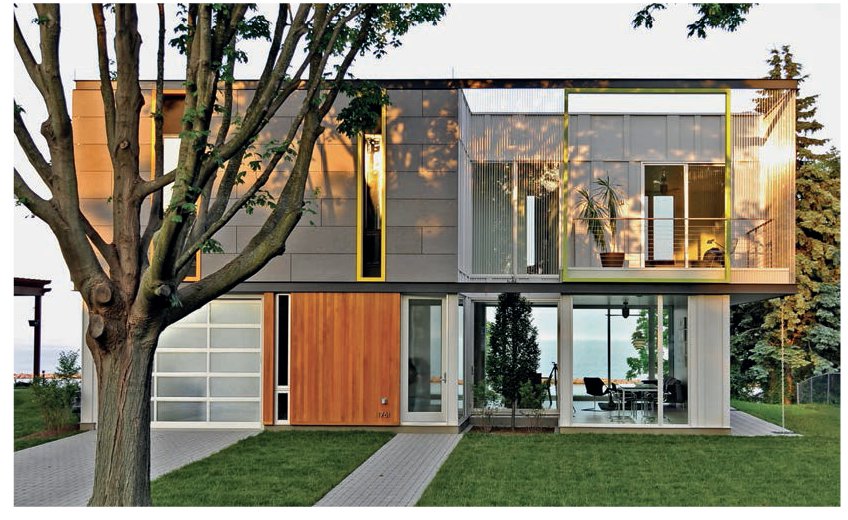
OS House respected the proportions of the neighbouring dwellings.
While the integration of technical systems can be costly and visible, the architects’ simple design was very thoughtful. By arranging the openings to face the water, the house has access to cool coastal breezes in the humid summer days. In addition, the inset windows use passive solar principles with overhangs that prevent the sun’s heat from raising indoor temperatures. Multi-layered walls and operable windows are carefully built to ensure air tightness and a high level of wall insulation. In the summer, the facade is well ventilated due to the space between the concrete slab and the inner, wooden oriented strand boards (OSB). Installing green features can extend construction time and raise budget, but in this case the house was completed within its original time frame and budget.
The success of the design also required commitment on the part of the occupants, who were willing to make adjustments to their lifestyle. For example, in contrast with most contemporary dwellings, the OS House features just one bathroom that is shared by all four members of the family. Yet, with a unique visual link to the surrounding street and lake, the house presents rich, livable and elegant qualities.

Axonometric view of the dwelling’s spatial organization.

The unit was designed to facilitate air flow and ventilation.

Axonometric showing the assembly process.
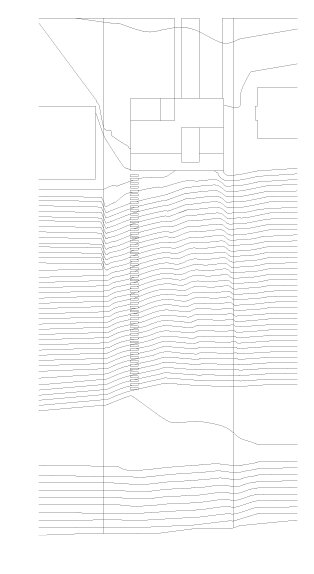
By arranging the house to face the water it has access to coastal breezes.
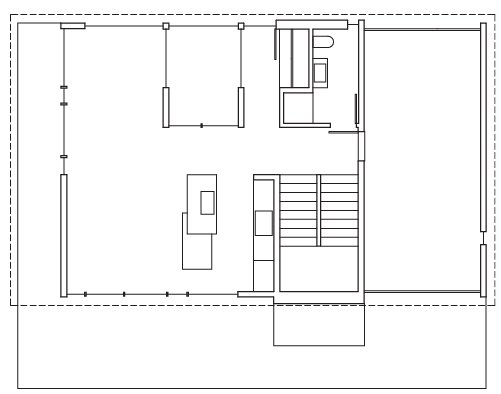
The ground floor demonstrates the house’s open plan concept.
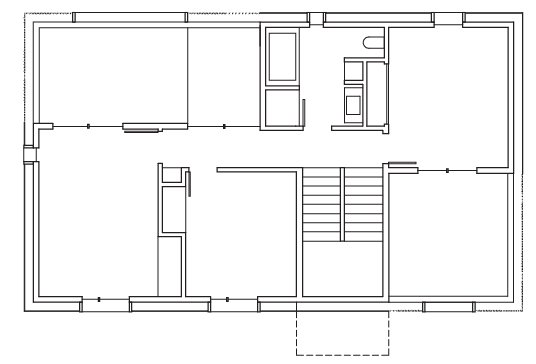
The second floor houses the bedrooms and has a single shared bathroom for environmental reasons.

Roof plan.
Acceptance and recognition of architecture develops over time. A Merit Award in 2010 by the American Institute of Architects noted that the OS House may be a model that exemplifies a future way of building sustainably.
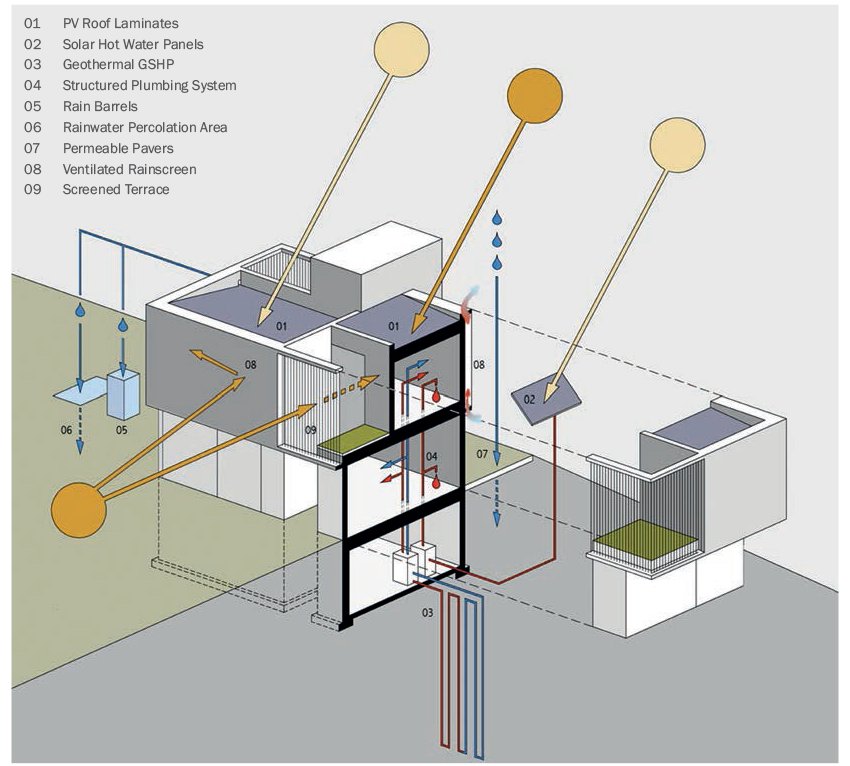
The green features of the dwelling which earned it a LEED Platinum rating.
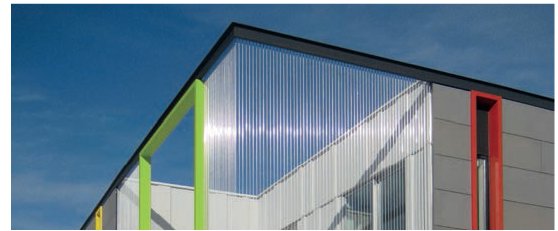
Facade detail showing the OSB boards used for the walls.
14.2 INNOVATIVE HEATING, VENTILATION AND AIR-CONDITIONING (HVAC) SYSTEMS |
|
Project |
Pryor House |
Location |
Montauk, New York, USA |
Architect |
Bates Masi + Architects |
Situated on a plateau at the northern end of an island, the Pryor house is surrounded by the sea and the natural environment of Montauk, New York. The architects, Bates Masi, designed the house for one of their sisters and her family, who wanted to trade city life for the outdoors. Since the clients wanted their dwelling to open to the landscape, the architects incorporated large operable windows and pocket doors. When the weather is warm, air is drawn to cross-ventilate the house, and when it is colder, the occupants can rely on their geothermal system.
The geothermal heating and cooling system accounts for the majority of the energy. The temperature in the ground stays fairly constant at 10°C (50°F) year- round and becomes an energy supply for the house through conduction and heat exchange. In the winter, when the average temperature is below freezing, heat is absorbed by the pipes and transferred to the house’s ductwork. For summer cooling, the reverse phenomenon occurs, whereby heat is transferred from the house into the ground, which is at a lower temperature.
Spatial arrangement in the two-storey house takes advantage of passive solar heat gain. The living room and the kitchen, on the ground floor, and the bedrooms on the first floor, have south-facing openings. Att he same time as integrating passive design principles, the house offers great scenic views of its surroundings. Multiple-layered bronze mesh in the clerestory windows on the second floor also provide additional shading and can be adjusted for optimal indoor brightness and desired temperature.
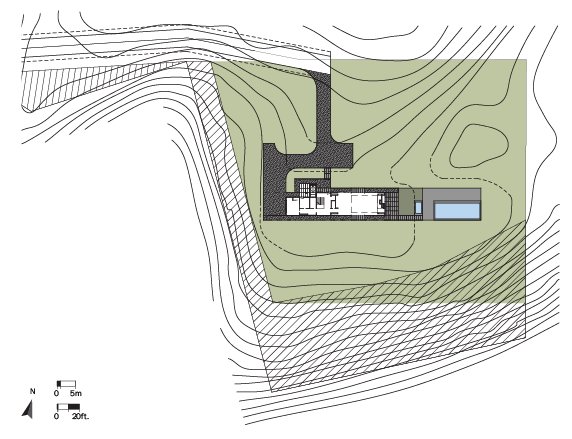
The house was sited on a plateau at the northern end of an island.
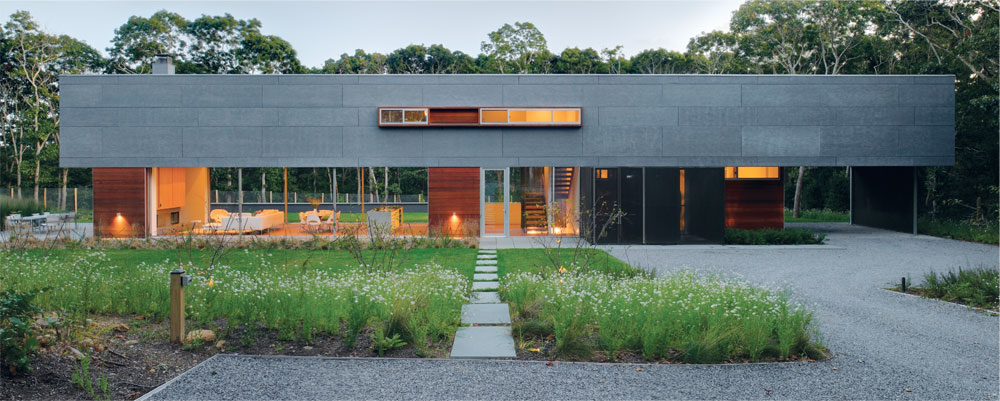
For viewing reasons, the house incorporates large operable windows and pocket doors.

Side view illustrates the house’s simple geometry.
Large floor-to-ceiling windows and multiple doors blur the boundaries between indoor and outdoor spaces. For example, a large glass door can slide open and lead the occupants into the living, dining and kitchen area from the exterior, while a smaller swinging door that leads to the patio offers a view of the ocean. Auxiliary spaces and transformations such as an outdoor shower, kitchen-turnedpicnic area and living room fireplace-turned-campfire create a camp-like experience for the family.
To save time and protect the site during construction, the home was built by assembling prefabricated sections and includes ‘green’ finishes. It respects both living requirements and high environmental standards, and creates pleasant indoor and outdoor experiences for its occupants.
The dwelling’s living spaces are south-facing for passive solar gain.
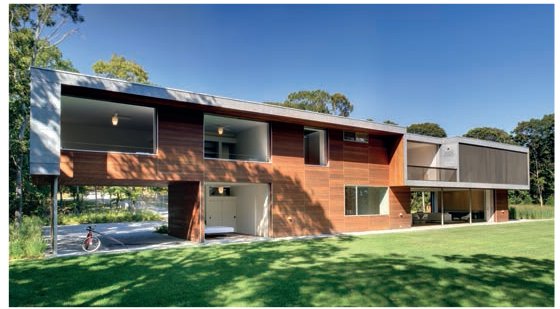
The rear view demonstrates the modular nature of the design.
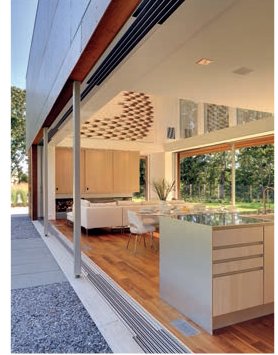
The living room is open to the outdoors for cross ventilation.
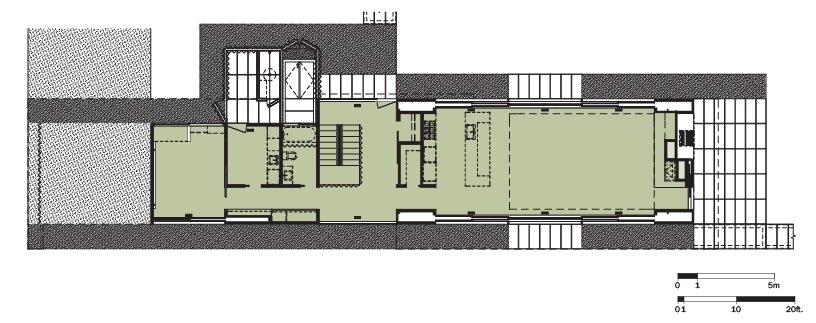
The spatial arrangement of the ground floor facilitates air flow.

The second floor’s bronze mesh provides additional shading.

Section showing the design’s modular nature.

